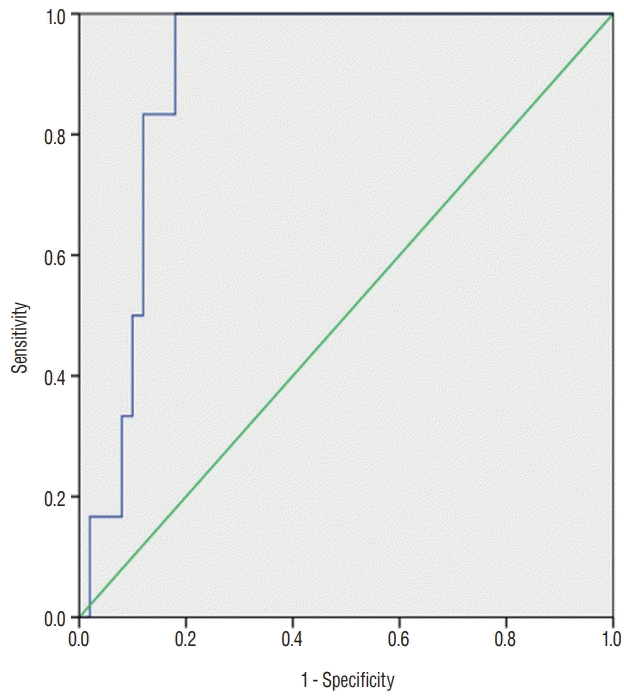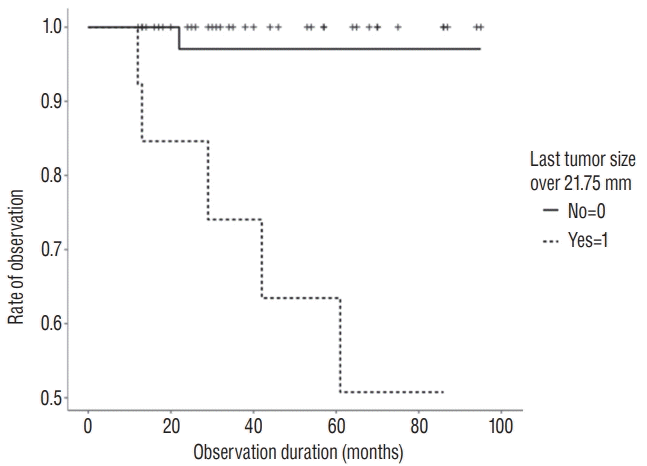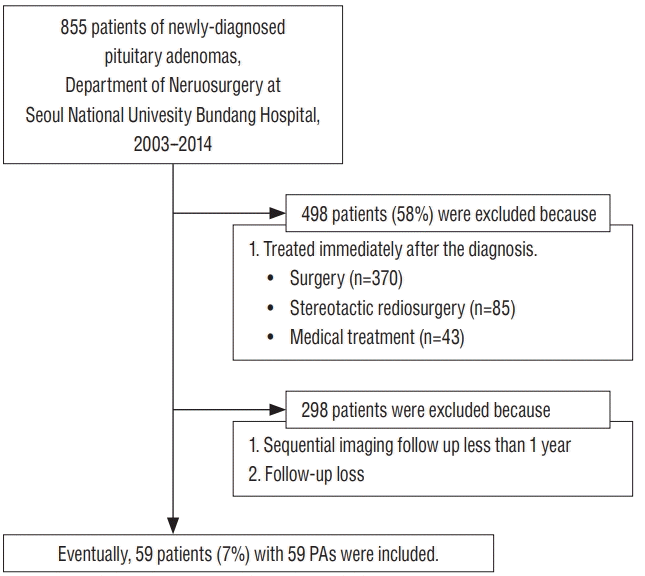1. Anagnostis P, Adamidou F, Polyzos SA, Efstathiadou Z, Panagiotou A, Kita M. Non-functioning pituitary adenomas: a single center experience. Exp Clin Endocrinol Diabetes. 119:314–319. 2011.

2. Arita K, Tominaga A, Sugiyama K, Eguchi K, Iida K, Sumida M, et al. Natural course of incidentally found nonfunctioning pituitary adenoma, with special reference to pituitary apoplexy during follow-up examination. J Neurosurg. 104:884–891. 2006.

3. Chacko AG, Chandy MJ. Incidental pituitary macroadenomas. Br J Neurosurg. 6:233–236. 1992.

4. Costello RT. Subclinical adenoma of the pituitary gland. Am J Pathol. 12:205–216.1. 1936.
5. Dekkers OM, Hammer S, de Keizer RJ, Roelfsema F, Schutte PJ, Smit JW, et al. The natural course of non-functioning pituitary macroadenomas. Eur J Endocrinol. 156:217–224. 2007.

6. Donovan LE, Corenblum B. The natural history of the pituitary incidentaloma. Arch Intern Med. 155:181–183. 1995.

7. Fernandez-Balsells MM, Murad MH, Barwise A, Gallegos-Orozco JF, Paul A, Lane MA, et al. Natural history of nonfunctioning pituitary adenomas and incidentalomas: a systematic review and metaanalysis. J Clin Endocrinol Metab. 96:905–912. 2011.

8. Freda PU, Beckers AM, Katznelson L, Molitch ME, Montori VM, Post KD, et al. Pituitary incidentaloma: an endocrine society clinical practice guideline. J Clin Endocrinol Metab. 96:894–904. 2011.

9. Greenman Y, Stern N. Non-functioning pituitary adenomas. Best Pract Res Clin Endocrinol Metab. 23:625–638. 2009.

10. Hall WA, Luciano MG, Doppman JL, Patronas NJ, Oldfield EH. Pituitary magnetic resonance imaging in normal human volunteers: occult adenomas in the general population. Ann Intern Med. 120:817–820. 1994.

11. Honegger J, Zimmermann S, Psaras T, Petrick M, Mittelbronn M, Ernemann U, et al. Growth modelling of non-functioning pituitary adenomas in patients referred for surgery. Eur J Endocrinol. 158:287–294. 2008.

12. Imran SA, Yip CE, Papneja N, Aldahmani K, Mohammad S, Imran F, et al. Analysis and natural history of pituitary incidentalomas. Eur J Endocrinol. 175:1–9. 2016.

13. Karamouzis I, Berardelli R, Prencipe N, Berton A, Bona C, Stura G, et al. Retrospective observational analysis of non-irradiated non-functioning pituitary adenomas. J Endocrinol Invest. 38:1191–1197. 2015.

14. Karavitaki N, Collison K, Halliday J, Byrne JV, Price P, Cudlip S, et al. What is the natural history of nonoperated nonfunctioning pituitary adenomas? Clinical Endocrinol (Oxf). 67:938–943. 2007.

15. Lania A, Beck-Peccoz P. Pituitary incidentalomas. Best Pract Res Clin Endocrinol Metab. 26:395–403. 2012.

16. Marsden JE, Tromba AJ. Vector calculus, ed 3. New York: W H Freeman & Co (Sd);1988. p. p241.
17. Orija IB, Weil RJ, Hamrahian AH. Pituitary incidentaloma. Best Pract Res Clin Endocrinol Metab. 26:47–68. 2012.

18. Reincke M, Allolio B, Saeger W, Menzel J, Winkelmann W. The ‘incidentaloma’ of the pituitary gland. Is neurosurgery required? JAMA. 263:2772–2776. 1990.

19. Sanno N, Oyama K, Tahara S, Teramoto A, Kato Y. A survey of pituitary incidentaloma in Japan. Eur J Endocrinol. 149:123–127. 2003.

20. Teramoto A, Hirakawa K, Sanno N, Osamura Y. Incidental pituitary lesions in 1,000 unselected autopsy specimens. Radiology. 193:161–164. 1994.

21. Varughese JK, Wentzel-Larsen T, Vassbotn F, Moen G, Lund-Johansen M. Analysis of vestibular schwannoma size in multiple dimensions: a comparative cohort study of different measurement techniques. Clin Otolaryngol. 35:97–103. 2010.







 PDF
PDF Citation
Citation Print
Print



 XML Download
XML Download